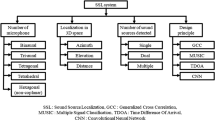Abstract
This paper suggests an effective estimation method of a sound source direction using an array of four microphones. We have used the array incorporated in the Microsoft Kinect device to acquire the binaural signals in real-time. The configuration of the microphone array has been inspired from how human auditory system processes sound waves. The microphone array is composed of four microphones that have been used in two pairs (P1 and P2) at the same diameter to mount the experimental setup. The distance of the array size was defined beforehand. The estimated direction provided by the angle of arrival (AOA) has been investigated. The sound source direction is estimated using the interaural time difference (ITD) measurement calculated by the generalized cross-correlation with phase transform (GCC-PHAT) function. To test the effectiveness of the estimation method, MATLAB trials are carried out under three different sound source distances. Experimental results show that the superiority of the sound source estimation can achieve a minimum accuracy of 92%.
Access this chapter
Tax calculation will be finalised at checkout
Purchases are for personal use only
Similar content being viewed by others
References
Strumillo, P. (ed.). Advanced in Sound Localization. Intech Open, Rijeka (2011)
Douaer.B,Y., Ykhlef, F., Ykhlef, F.: Tracking a sound source in two dimensions using microsoft kinect sensors. In: IEEE, Proceedingof the International conference on Advanced Electrical Engineering, pp. 1–4 (2019)
Gombots, S., Nowak, J., Kaltenbacher, M.: Sound source localization - state of the art and new inverse scheme. e & I elektrotechnik und informationstechnik 1–5 (2021)
Sam Kim, S., et al.: Preference for robot service or human service in hotels? Impacts of the COVID-19 panademic. Int. J. Hospitality Manage. 93, 102795 (2021)
Khanal, A., et al.: Search Disaster Victims using Sound Source Localization. ArXiv preprint:2103.06049 (2021)
Nakamura, K., Lana, S., Nakadai, K.: Interactive source localization using robot audition for tablet devices. In: Proceedings of IEEE/RSJ International Conference on Intelligent Robots and Systems (IROS), pp. 6137–6142 (2015)
Li, X., Girin, L., Badeig, F., Horaud, R.: Reverberant sound localization with a robot head based on direct-path relative transfer function. In: EU-FP7 STREP project, EARSarXiv, vol. 03574 (2020)
Evers, C., et al.: The LOCATA challenge: acoustic source localization and tracking. In: IEEE/ACM Transactions on Audio, Speech, and Language Processing, vol. 28 (2020)
Vargas, E.B.K., Subr, K.: Impact of microphone array configurations on robust indirect 3d acoustic source localization. In: IEEE International Conference on Acoustics, Speech and Signal Processing (ICASSP), pp: 3221–3225 (2018)
Jarrett, W., Ashley, J.: Beginning Kinect Programming with the Microsoft Kinect SDK. Apress, Berkely (2012)
Saggese, A., et al.: A real-time system for audio source localization with cheap sensor device. In: IEEE, International Conference on Advanced Video and Signal Based Surveillance (AVSS), pp. 1–7 (2017)
Douaer, B., Ykhlef, F., Ykhlef, F.: experimental investigation into the influence of the distance between microphones for 2D real-time sound source localization using GCC-PHAT technique. In: Senouci, M.R., Boudaren, M.E.Y., Sebbak, F., Mataoui, M. (eds.) Advances in Computing Systems and Applications. CSA 2020. Lecture Notes in Networks and Systems, vol. 199, pp. 354–362. Springer, Cham (2021). https://doi.org/10.1007/978-3-030-69418-0_32
May, T., van de Par, S., Kohlrausch, A.: A probabilistic model for robust localization based on a binaural auditory front-end”. IEEE. Trans. Audio Speech Lang. Process. 19, 1–13 (2011)
Sound source: http://catalog.ldc.upenn.edu/LDC93S1. Accessed: 29 Jun 2021
Author information
Authors and Affiliations
Corresponding author
Editor information
Editors and Affiliations
Rights and permissions
Copyright information
© 2022 The Author(s), under exclusive license to Springer Nature Switzerland AG
About this paper
Cite this paper
Douaer, B. (2022). Improved DOA Estimation Method for Sound Source Direction Based on Binaural Signals Using an Array of Two Pairs of Microphones. In: Hatti, M. (eds) Artificial Intelligence and Heuristics for Smart Energy Efficiency in Smart Cities. IC-AIRES 2021. Lecture Notes in Networks and Systems, vol 361. Springer, Cham. https://doi.org/10.1007/978-3-030-92038-8_53
Download citation
DOI: https://doi.org/10.1007/978-3-030-92038-8_53
Published:
Publisher Name: Springer, Cham
Print ISBN: 978-3-030-92037-1
Online ISBN: 978-3-030-92038-8
eBook Packages: Intelligent Technologies and RoboticsIntelligent Technologies and Robotics (R0)




